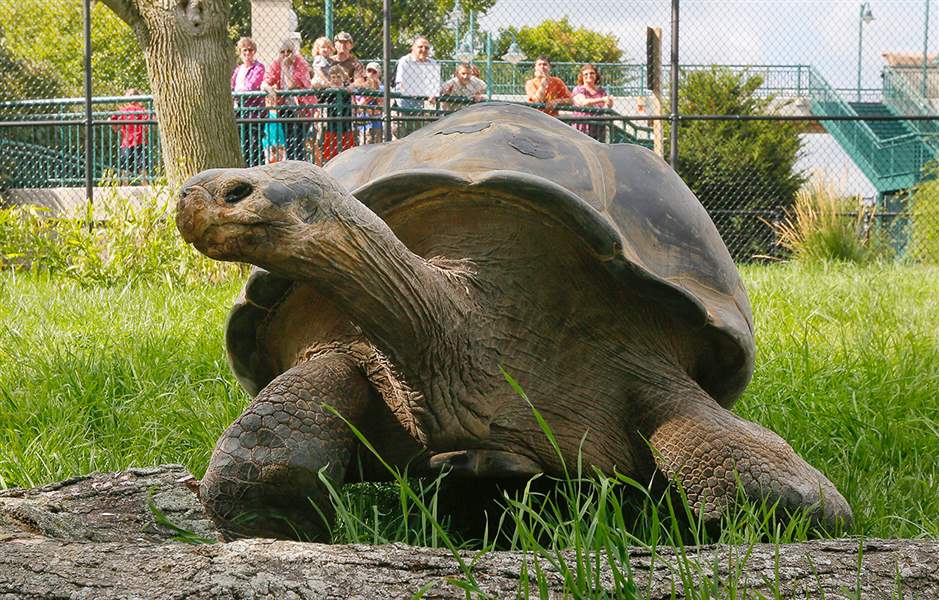
Slow-moving tortoise quick to greet visitors
New reptile wastes little time making itself at home
8/29/2014
Visitors watch as Emerson, the Galapagos tortoise, explores his temporary exhibit at the Toledo Zoo.
THE BLADE/AMY E. VOIGT
Buy This Image

Visitors watch as Emerson, the Galapagos tortoise, explores his temporary exhibit at the Toledo Zoo.
He might move achingly slow, but the Toledo Zoo’s new Galapagos tortoise will be quick to steal visitors’ hearts.
Emerson, a wild-born tortoise estimated at 100 years old, arrived in Toledo from the San Diego Zoo on Wednesday night. He took his first steps into his new world Thursday morning when keepers let him out of a heated shed where he spent the night.
The 440-pound reptile, who was a little jet-lagged and slow to wake up, had tucked himself head-first into a corner of the shed and had to figure out how to get turned around. Keeper Val Hornyak offered him veggie treats and, after pausing for a moment to soak up some sun, Emerson descended a short ramp onto the grass.
Emerson is an ambassador for his wild counterparts back in the Galapagos Islands, which inspired Charles Darwin and his theory of evolution. The populations of tortoises there were nearly obliterated in the 1800s, putting them on the endangered list today.
PHOTO GALLERY: Click here to view slideshow.
“Someone figured out that tortoises could live in the hold of a ship for months, maybe even up to a year, without food or water. That solved their problem for lack of fresh meat at sea,” said Linda Cayot, the science adviser for the Galapagos Conservancy in Virginia and a well-known Galapagos tortoise expert.
Ms. Cayot said an estimated 100,000 to 200,000 tortoises were taken off the islands within a span of about 50 years. There are just 15,000 to 20,000 left, and four of the 14 identified subspecies are considered extinct.
“One of the problems with a very long-lived animal is that the populations don’t grow rapidly,” she said. “But that’s also why we still have them.”
No one yet knows the average lifespan of Galapagos tortoises because they live so long and tracking the animals with known hatching dates takes several generations of humans. Ms. Cayot said experts estimate the giant reptiles may live anywhere from 150 to 200 years.
Each of the main islands in the volcanic archipelago had its own subspecies of giant tortoise, with Isabela Island having five subspecies around the five major volcanoes there.
The native tortoises of Floreana, Santa Fe, and Pinta islands are extinct because of human exploitation. The Fernandina Island tortoise is considered extinct because of volcanic activity.

“Now we’re working to rebuild,” Ms. Cayot said. “It’s been super successful, it just takes a long time.”
The Galapagos National Park runs a breeding center where hatchlings from eggs either laid at the center or collected from the wild are raised for several years until they are large enough to avoid problems with predators introduced to the islands by humans. They are then returned to their subspecies’ respective islands.
Whalers sometimes dropped off tortoises on different islands, leading to hybrid tortoises that might help restore extinct subspecies.
“One of the most exciting things now is that geneticists have discovered tortoises on Wolf Volcano on Isabela Island that have partial genetics from Floreana and Pinta,” Ms. Cayot said. “Now we’ve found a source to begin getting tortoises back to Floreana and Pinta that are as close as possible to the native ones that are extinct.”
Caring for tortoises is a delicate task, particularly away from their equatorial home. Zoos in the United States have to ensure the reptiles are warm and can get enough sunshine and fresh air.
“They’re much more complex an animal than people think,” said Colette Adams, general curator at the Gladys Porter Zoo in Brownsville, Texas, and vice coordinator of the Galapagos Tortoise Species Survival Plan.
Emerson will be moved off exhibit when the weather cools and be placed in a large barn with heated floors for the winter. As it is now, he has to spend his nights tucked safely inside a heated and insulated shed.
“Even in south Texas, we have to make arrangements for our herds to have heated shelters in the winter time,” Ms. Adams said. “In northern zoos, it’s more challenging. They have to accommodate the fact that they have cold weather for a longer portion of the year.”
The Toledo Zoo plans to start building a permanent, year-round exhibit for Galapagos tortoises in three to five years. That project is to be included in the zoo’s next capital outlay plan being put together now.
“Nowadays, with the right amount of money, zoos can build an exhibit with indoor/outdoor capabilities,” Ms. Adams said. “When they can’t be outside, there are commercial UVA/UVB lights that simulate the sun they need.”
Emerson is already a show-stopper. He wasted no time on his first day outside quickly — for a tortoise — heading over to silently greet some adoring onlookers, tasting the grass and a dandelion along the way.
He investigated and ran over a grassy plant and a log on his slow lap of the yard, and showed off his long neck by stretching out for neck rubs from keepers.
Later this year, three 2-year-old Galapagos tortoises will come to Toledo from the Texas zoo Ms. Adams oversees. Generations of visitors will get to watch them grow into hulking behemoths like Emerson.
“I don’t think there is a single animal that holds the same deep, rich history and lore that Galapagos tortoises do,” Ms. Adams said. “They are amazing animals.”
Contact Alexandra Mester: amester@theblade.com, 419-724-6066, or on Twitter @AlexMesterBlade.